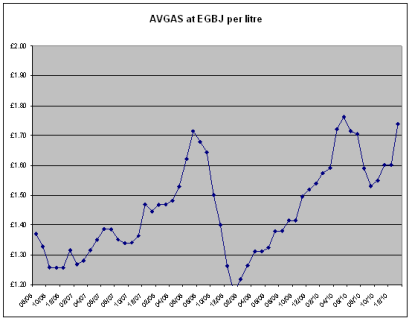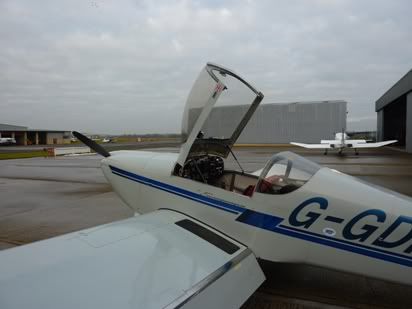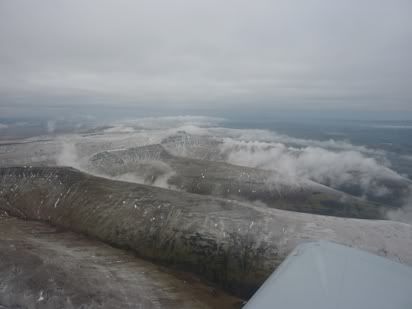I checked the weather there on their excellent website as they only have one runway in use at weekends, and I wanted to know what crosswind I would be facing, if any. Turned out to be 030/07, so it would be 36 with a slight crosswind component from the right. I called them for PPR as per the plates, but they seemed to just want my details in advance.
I bumped into a few fellow Flyer Forumites in Cotswold Aero Club, Hogster, Johnm and Timmy P. It is one of those surreal moment when you meet people you have been ‘talking to’ via a bulletin board only – ‘Hello, I am Karg the destroyer of worlds, you must be Mekon emperor of the seventh quadrant!’ – well not quite, at least we have semi-sensible forum names – I am Steve H – original huh? Anyway, I was put to shame as one was going to Calais and the other two were going to Gamston. Here’s me only scuttling along 20 minutes to Wellesborne, oh well, plan the flight and fly the plan!
I checked the plane out and Rob helped me pull it out of the hangar past the Citation jets. I tried the normal startup routine, and again and again and again. It was very cold and had been for the previous few days and no one had flown her for a week, so she was very cold and ratty! I primed and tried again, a splutter then dead. I carefully primed some more. By now I was worried in case I had flooded the engine, but no smell of fuel, so more priming. Eventually she caught and the battery seemed none the worse for the experience. Taxi to the pumps to put some fuel in, called for clearance and we had the ‘long march of death’ around to C1 for 09 – oh well, I needed a little while to get the oil up to temperature anyway!
After power checks I was cleared for take off for the short flight to Wellesborne. I climbed to 2100’ and it started to get very murky, at 2200’ I was almost in poorly defined murky clouds, so I dropped to 2000’ and dinked left to swing north around the Cotswold ridge rather than head straight over it. Yes, it was murky up there, although lateral visibility was OK, they were saying 10km or more on the ATIS, but I can only assume they had not been flying as it seemed a little less than that. In no time at all, I was switching from Gloster to Wellesborne and calling for airfield information (it is only a 20 minute run). As expected, they were giving 36 with left had circuits and the wind was as expected.
I carried out a standard overhead join, slotted into the traffic already in the circuit and swung her onto final. As usual, I left myself a bit high, a bit of sideslip took care of that. A bit fast, but then I do want to land a bit long, so I’ll bleed that off with a longer flare. Over the numbers and rounding out, hold off and off and off and off. We are heavy, but this is taking a while. Little bit of crosswind, dab of rudder to straighten and we touch – and stay touched. A little into wind aileron, dance on the peddles until she is down to taxi speed, yes, there we go. Well false modesty aside, that was about as good a landing as you can do in the RV – very smooth (I was of course to pay for this hubris later!).
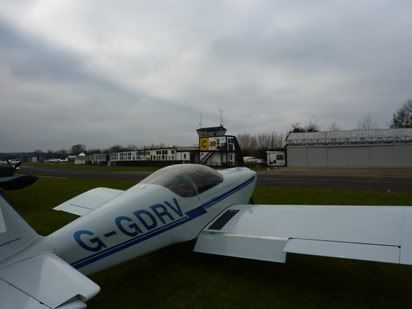
G-GDRV parked up at Wellesborne
We parked up and dutifully trotted into the tower to pay. £15 landing fee and a friendly welcome. I asked about getting to the intact Vulcan bomber on the north west perimeter. They said if I had a hi-vis vest, we could walk along the taxiway. It was a good half mile and the wind (such as it was) made the sub-zero temperature feel a lot worse.
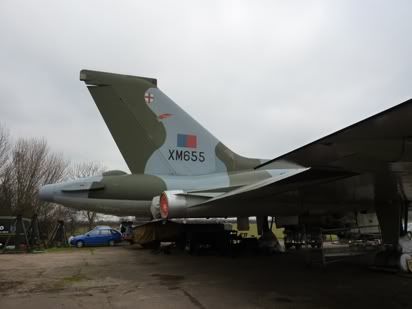
The mighty Avro Vulcan
We were happy to be in the lee of the mighty Vulcan. Sure enough, there were many volunteers at the Vulcan. They had one of the engine out for overhaul. They were very friendly and welcomed us in and chatted about the plane. I knew something about Vulcans, but of course not as much as them. I was surprised to learn that the engine did not have after-burners and that this was the later and more powerful Olympus 301 engined version.
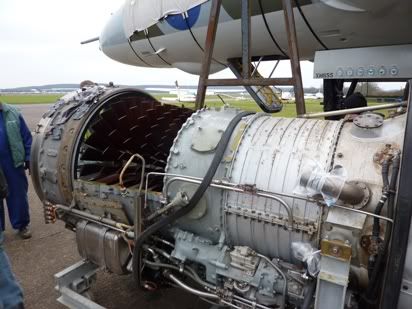
One of the working Olympus 301 engines being serviced
We had a wander around and had a close up of one of the partially stripped engines. It is a real treat to see a real, running engine being overhauled, not some dead, lifeless hulk that has been dissected in a museum somewhere. I was surprised at how small it seemed.

Lovely clean turbine blades
I was grateful for the tour and offered a donation to a lady in one of the portakabins. She immediately offered us a trip into the crew compartment. That too was a treat. I was amazed at how cramped it was and what a truly lousy view the pilots had. It was the usual chaos of black panels and switches and dials scattered around seemingly at random – no digital stuff here, oh no! I thought the two London Underground tube train flexible hanging handles in the ceiling of the crew compartment said it all – period British pragmatism, hey if they work, stick them in there!

Possibly the most cluttered and worst designed panel ever
We made our way back, now quite cold, to the ‘new’ café. Well, it looks very much like to old café to me! Having said that, it is perfectly fine. There are normally a lot of locals that turn up with families for a fried breakfast and to watch the planes, which I think is an excellent thing. There is a great deck looking onto the airfield with tables etc., but no takers on a cold day like this. It would be a nice spot in the summer though.
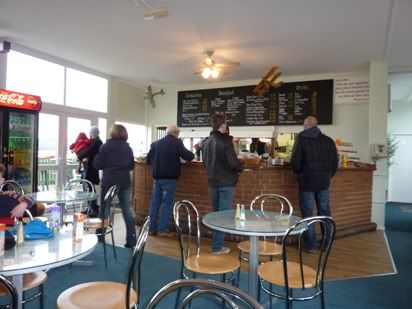
The 'new' cafe - different from the 'old' cafe....err....how?
We didn’t hang around and soon mounted up for the return trip. The plane started first time as we taxied for the hold for 36. The tower again confirmed the noise abatement procedures as I lined up, applied power and started hopping eagerly along 36 (the plane was moving down the runway too!). Up we went and I turned onto 030 and glimpsed the green roofed building we were aiming for. Nicely on track. At 1200’ I turned left onto direct track back to Gloucester. I could still only manage 2100’, but that was fine.
Picked up the ATIS and called for rejoin. Got the expected standard overhead for 09 although the wind was a mild 030/05. I wasn’t sure why they hadn’t switched to runway 04, but I was OK with that wind. The circuit was quiet with only one other in as I called final. OK, a bit high and a bit fast. Slipped some of it off, but still a bit fast. Over the threshold aiming to land long, flared, a bit high though, felt her down, no real stall warner, we touched and I guess I knew what was going to happen. Now after my last landing which was really good, you would have thought the plane would say ‘Y’know Steve, that last one you did was really good, so I’ll let you off this one’ – but no. The RV has no such memory. I was punished with a bounce. As we were heading back up it is amazing how quickly you think. By the time we got to the top of the bounce and were about to come down a second time, I weighed up the pro’s and cons and thought that yes, I could control this mext one and land, but it would be messy and anyway, what is the hurry, so I pushed in the power and the engine and aircraft responded beautifully into a go around, as if to say to me ‘good decision, coz I was going to kick your ass if you tried anything else!’.
This was the first go around I have done for a few years, so probably long overdue anyway. I explained to Rob who was (or at least seemed to be) unconcerned. The second approach was better and my second landing was almost as good as the one at Wellesborne, certainly the plane seemed happy with it. What was it my PPL instructor used to say? ‘A good landing comes from a good approach’ – how true.
Taxied in and shut down. Rob help me put the plane away and we got it precisely into it’s tight slot first time with very few instructions.
Well all in all, poor weather but a really nice flight. It would be nice if the heater could be a little more efficient though. Loved seeing the Vulcan, well worth it for that alone.

